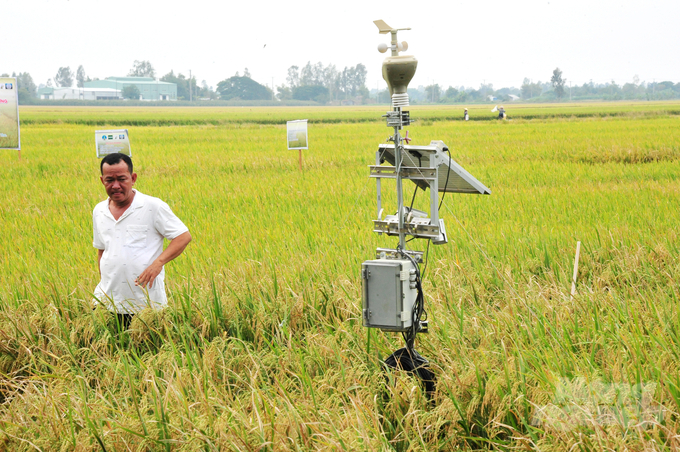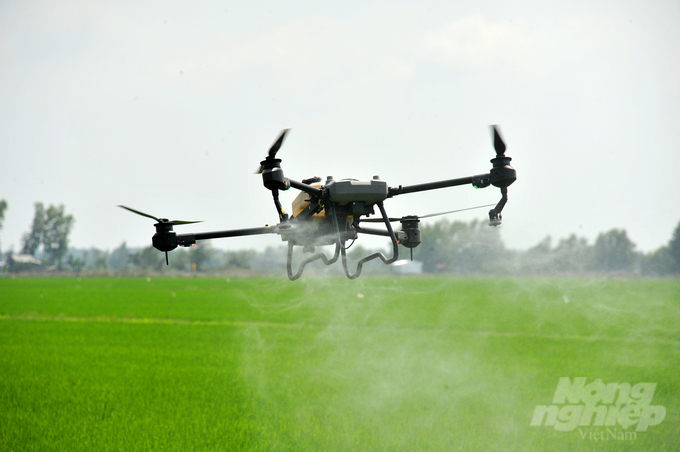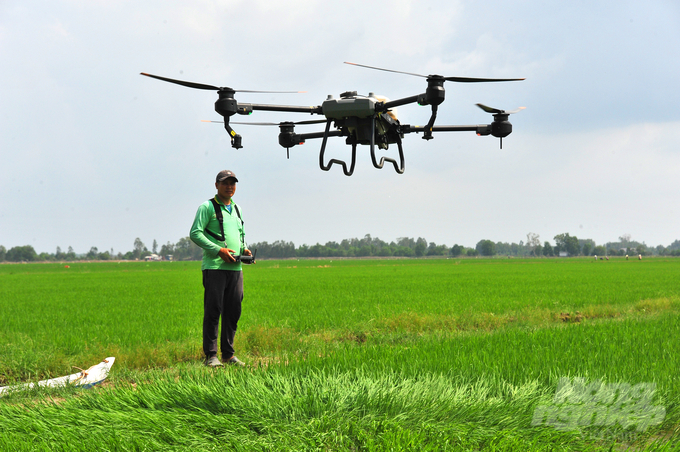Farmers proudly apply Technology 4.0
Almost 4.2 million hectares are cultivated in the Mekong Delta every year, with a total production of about 24 million tons of rice, of which about 50% is for domestic consumption and 50% for export. Through the use of technical advances in production, the yield and quality of rice has been continuously improved in the past.

Farmers use sensor stations in rice cultivation. Picture: Le Hoang Vu.
However, according to agricultural experts, this growth still does not correspond to the potential of this delta. In particular, rice production costs are still high, crop failures due to natural disasters and epidemics are still common, severely affecting production and farmers’ lives.
Today, with the advancement of science and technology, especially the acceptance of 4.0 technology, rice farmers need only open their smartphones to update anywhere and anytime. Receive important indicators in their rice fields to deal with it proactively and in a timely manner. With the data collected by mobile device monitoring systems installed in the field, farmers can know the status of the irrigation water, pH, salinity and depth. Diseases, as well as weather changes, can take proactive rice care measures.
This is an effective way to reduce risks, reduce costs, increase productivity and quality of bulk rice, and switch to modern and sustainable agriculture. Farmers refer to this fairly new form of production as long-distance rice cultivation.
In recent years, several provinces and cities in the Mekong Delta have been supported by the agricultural sector to install a range of monitoring systems in the fields, such as Such as hydrometeorological monitoring stations, insect monitoring sensor stations, etc., which help farmers to take proactive action rice cultivation in several important stages and contributed to gradually develop new methods of rice cultivation in the Mekong Delta.
Farming has never been so easy
With the support of Dong Thap Provincial People’s Committee, My Dong 2 Agricultural Services Cooperative (My Dong 2 Cooperative) in My Dong Township (Thap Muoi District) has built a system of electric pumping stations combined with infrastructure (canals, field transport), electricity, intelligent irrigation systems for rice production) and model 4.0 that adapts to climate change and supplies the 170 ha area of the cooperative.

Farmers in the Mekong Delta use a smart pest monitoring station. Picture: Ho Thao.
Mr. Ho Van Muoi, deputy director of My Dong 2 cooperative, said: In the past, there was also a pumping station in this area, but its scale was small and not enough to meet people’s production needs. Since 2017, with the attention of leaders at all levels, the province has supported over VND 30 billion to build infrastructure such as canals, field transportation, electricity and intelligent irrigation systems to save money. reduce water and production costs.
According to Mr. Muoi, it is an extension model of the point model piloted by My Dong 2 Cooperative in cooperation with Rynan Technologies Vietnam Joint Stock Company (Rynan Company) from the 2017-2018 winter-spring crop with an area of 7,6ha. Due to the model’s effectiveness in reducing seed, fertilizer, labor and water-saving costs, Dong Thap Province has expanded the project to hundreds of hectares in the cooperative. Accordingly, the province invests in infrastructure elements. Rynan Company is supplying equipment to control alternate flood and dry irrigation mode according to cloud computing technology at a total cost of over VND 30 billion.
The combination of water level monitoring parameters, sensor tube to control alternating wet and dry irrigation and a pump control station allows the cooperative to conveniently adjust the water level in the field. Concretely, the electric pumping station system consists of 2 pumps controlled by a sensor system, so the control center manager only needs to use a smartphone with internet connection to control the pumping station system remotely. Bringing water to the field at the right time, at the right time and automatically via smartphones. In addition, this model also helps to save water and increase the value and profit of rice producers.

For many years, farmers in the Mekong Delta have used drones to spray pesticides, fertilize and sow rice. Picture: Le Hoang Vu.
According to calculations by the deputy director of the My Dong 2 cooperative, this pumping station system will help reduce the cost of pumping water by 30% by reducing the time. Specifically, if a normal pump takes 2-3 days to fill up with water, this inverter pump only takes 1.5 days to pump water for hundreds of acres of fields that farmers have not used. It doesn’t take much effort.
“As a wet rice plant, rice doesn’t always need water. Depending on the respective development and growth phase, farmers provide water according to the needs of the rice crop,” said Dien.
Mr. Nguyen Van Te, a member of My Dong 2 cooperative, which cultivates 3.5 hectares of rice, said: Since the winter-spring harvest in 2020, he no longer has to go to the field, but he can still immediately see the necessary indicators in the rice detect field such as humidity, salinity, pH, water level. This allows the rice cultivation to be proactively managed in a timely manner. According to Mr. Te, farming has never been so convenient and easy. All thanks to the hydrometeorological monitoring system and the application of new technologies in rice cultivation.
Mr. Kim Khac Dien, representative of Rynan Technologies Vietnam Joint Stock Company analyzed: “In agricultural production, rice is the crop that uses the most water. Productivity Guarantee.”
Thanks to the government-funded hydro-meteorological monitoring system, it is very convenient for farmers to apply water-saving irrigation techniques in rice cultivation through alternate flood-drying methods. This is a technical advance whose application and imitation in the agricultural industry is encouraged.
New service for rice cultivation
In large-scale rice cultivation, in the modern direction, the traditional method has revealed many disadvantages, such as: B. labor-intensive, high cost and the accuracy of the dosage, also the spray quantity is not as desired.
In recent years, drone (unmanned aerial vehicle) pesticide spraying has become a new agricultural tool, which not only helps farmers improve work efficiency and reduce production costs, but also helps stabilize productivity. The application of this new technology in rice cultivation is an important transformation step and creates new services to increase the income of many households in the Mekong Delta.

The use of drones in rice cultivation represents a major shift, creating new services that increase the income of many households in the Mekong Delta. Picture: Ho Thao.
Mr. Le Quoc Trung (Tram Chim Town, Tam Nong District, Dong Thap), who cultivated 30 hectares of rice, used to have to mobilize more than a dozen people to help with field work whenever pesticides needed to be sprayed in the past. In recent years, his family has invested more than 1 billion dongs in two drones, making it easy to spray pesticides, fertilizer and sow rice. This job is not only convenient, but also provides his family with a fairly high income due to the part-time employment.
Trung said it is these benefits that have now led to the establishment of many drone service groups in the Mekong Delta. In addition to spraying pesticides, drones are also used for rice seeding and fertilizer, helping to relieve thousands of local workers.
The beauty of Drone is that the system’s memory software updates details about each spray, e.g. B. Time, amount, list of fertilizers and pesticides. This is also a field diary that allows rice farmers to control all farming activities and, more importantly, trace the origin of agricultural products.
Currently, municipalities continue to encourage and support farmers and farmer organizations to use drones in large fields and agricultural cooperatives. This is also the development trend of modern and sustainable agriculture.

